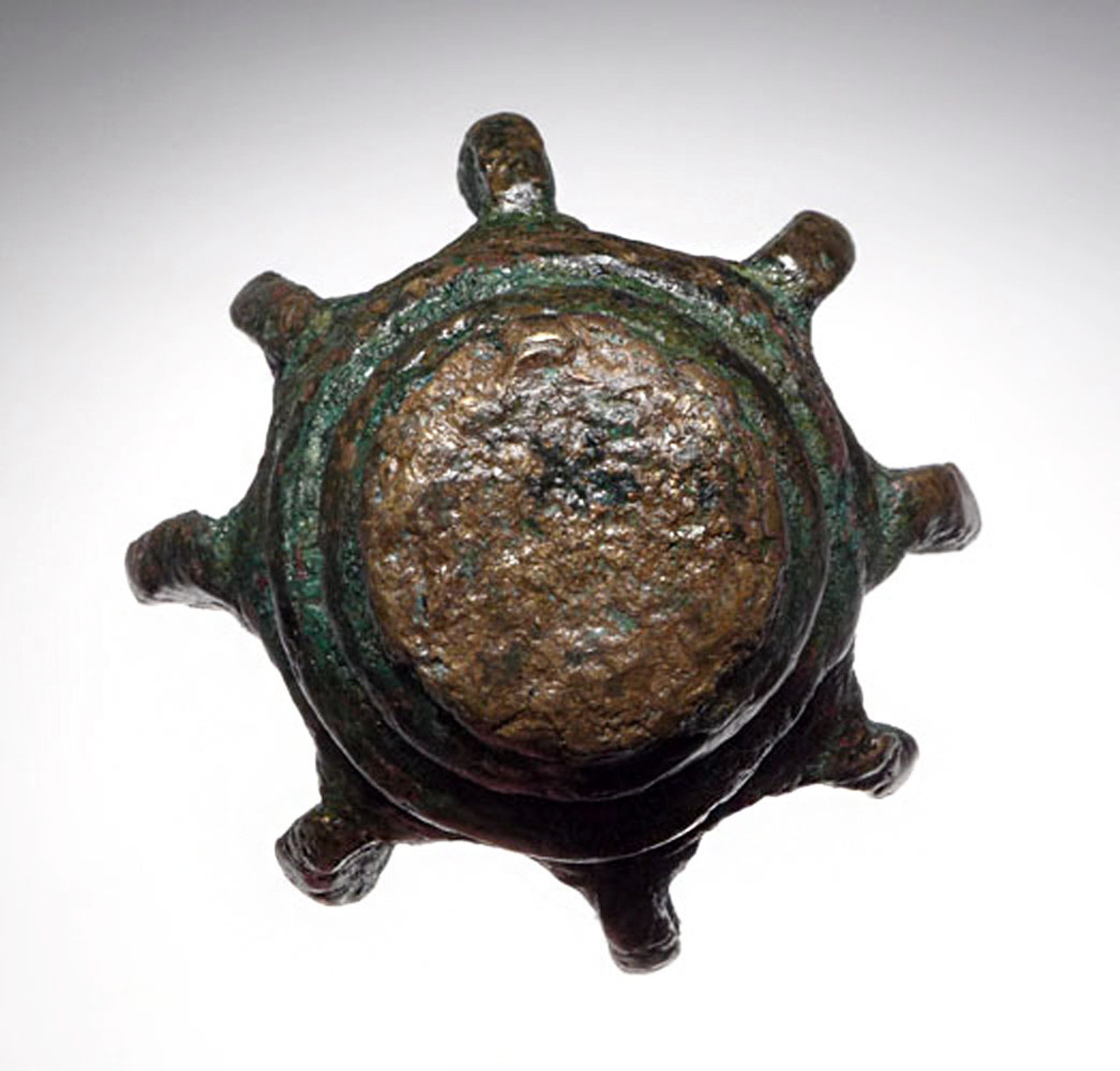Product Description
SEE MORE ANCIENT NEAR EASTERN ARTIFACTS
Seljuk militaria is very rare on the market and we are pleased to offer the first and only specimen in this superb flanged war mace head. Made of heavy cast bronze, it was likely this was a weapon of a high ranking officer as most of the common weapons of the period were iron. The original bright golden color of this mace would have been a show of leadership and command, identifying ranking officers to their subordinate soldiers in the heat of battle. It features an excellent state of preservation with all flanges intact. Typical Seljuk mace head motif designs can be seen in the faint detail of beaded decorations running over the top of the flanking ridges at the base of each flange. Most of this is concealed by the encrustations but some areas reveal this where the metal is exposed. Several areas on the mace are seen where it was attached securely to a wooden shaft handle with evidence of use and re-use indicating this was a weapon of prestige, as well as being highly valued by the soldier that originally owned it. With its heavy cast weight, it would have been a deadly effective weapon mounted on the end of a long shaft and swung from a moving cavalry horse.
Ancient militaria of this level very rarely makes it to the public market. This is an extremely rare offering and is the only Seljuk ancient Islamic mace head we have ever offered or will offer. It will provide a lifetime of pride to the knowledgeable advanced collector that makes it theirs, as it once did for the ancient warrior that carried it into battle.
This artifact has been professionally cleaned and conserved in our lab, being treated with a special sealer developed and formulated by us specifically for ancient metal preservation. The patina shows beautiful traits only found in authentic ancient weapons. It is a patina like this that the finest ancient bronzes are prized for and it is a patina like this that brings a premium in price and value of the specimen. There is no active bronze disease. Bronze disease can develop on ancient bronze that is not properly cleaned and conserved. It produces a corrosive powder that will literally eat away an artifact over time and destroy it.
HISTORY
The Seljuk Empire, was a Turko-Persian Sunni Muslim empire originating from the Qiniq branch of Oghuz Turks. At the time of its greatest extent, the Seljuk Empire controlled a vast area, stretching from western Anatolia and the Levant in the west to the Hindu Kush in the east, and from Central Asia in the north to the Persian Gulf in the south.
The Seljuk empire was founded in 1037 AD by Tughril Beg (990–1063) and his brother Chaghri Beg (989–1060). From their homelands near the Aral Sea, the Seljuks advanced first into Khorasan and then into mainland Persia, before eventually conquering Baghdad and eastern Anatolia. The Seljuks won the battle of Manzikert in 1071, and then conquered most of the rest of Anatolia, wresting it from the Byzantine Empire. This was one of the impetuses for the First Crusade (1095–1099). The Seljuk empire began to decline in the 1140s, and by 1194 had been supplanted by the Khwarazmian Empire.
The Seljuk empire united the fractured political landscape of the eastern Islamic world and played a key role in the first and second crusades. The Seljuks also played an important part in the creation and expansion of multiple art forms during the period in which they had influence. Highly Persianized in culture and language, the Seljuks also played an important role in the development of the Turko-Persian tradition, even exporting Persian culture to Anatolia. The settlement of Turkic tribes in the northwestern peripheral parts of the empire, for the strategic military purpose of fending off invasions from neighboring states, led to the progressive Turkicization of those areas.
The Byzantine–Seljuk wars were a series of decisive battles that shifted the balance of power in Asia Minor and Syria from the Byzantine Empire to the Seljuks. Riding from the steppes of Central Asia, the Seljuks replicated tactics practiced by the Huns hundreds of years earlier against a similar Roman opponent but now combining it with new-found Islamic zeal. In many ways, the Seljuk resumed the conquests of the Muslims in the Byzantine–Arab Wars initiated by the Rashidun, Umayyad and Abassid Caliphates in the Levant, North Africa and Asia Minor.
During the course of the war, the Seljuk Turks and their allies attacked the Fatimid Caliphate of Egypt, capturing Jerusalem and catalyzing the call for the First Crusade. Crusader assistance to the Byzantine Empire was mixed with treachery and looting, although substantial gains were made in the First Crusade. Within a hundred years of Manzikert, the Byzantines had successfully driven back the Turks from the coasts of Asia Minor and extended their influence right down to Palestine and even Egypt. Later, the Byzantines were unable to extract any more assistance, and the Fourth Crusade even led to the sack of Constantinople in 1204.
 US DOLLAR
US DOLLAR
 EURO
EURO
 AUSTRALIAN DOLLAR
AUSTRALIAN DOLLAR
 CANADIAN DOLLAR
CANADIAN DOLLAR
 POUND STERLING
POUND STERLING




















